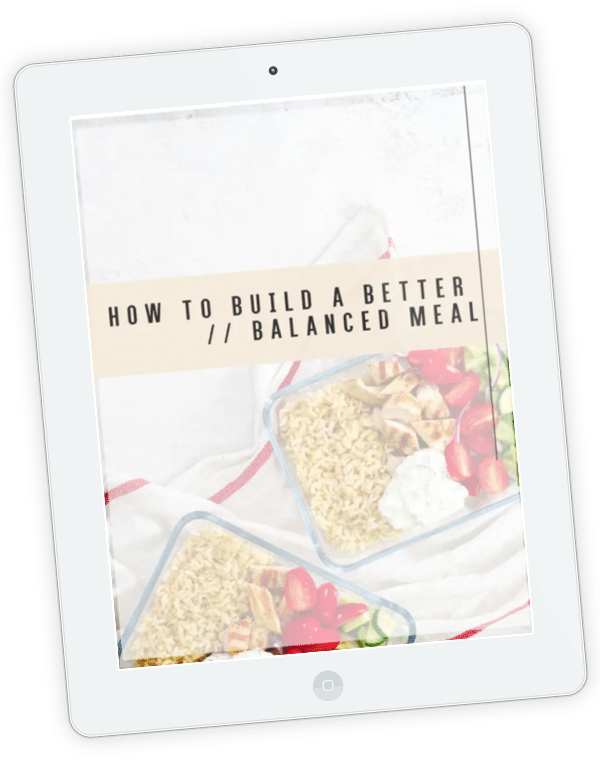A Woman’s QuickStart Guide to Intermittent Fasting
To fast or not to fast? From weight loss to aging, there is a lot to unpack with intermittent fasting. Let me break it down for you, step by step, so you can decide if this popular eating approach is for you.
What is intermittent fasting?
In short, intermittent fasting is when you alternate periods of eating with periods of fasting. While there are many variations of this diet, one thing remains consistent: this eating pattern focuses more on the when and less about the what.
Let’s be clear: fasting does not mean we are having cookies and cake for lunch and dinner. What you eat matters, you just don’t have to be uptight and obsessive about it. That’s what makes intermittent fasting standout from the competition.
- No calorie counting.
- Less hassle.
- All foods.
…yes, even pizza fits on this plan!
Fewer decisions about what to eat and when and less time spent in the kitchen meal prepping is a WIN for those of us trying to juggle families, work, social lives, and personal wellbeing.
And here’s the thing: fasting has been around for centuries. People fast for cultural and religious reasons (Ramadan, Yom Kippur), or sometimes as a protest against social and political issues. Remember our friend, Mahatma Gandhi?
Even though the practice itself isn’t new, fasting for health benefits is a more recent trend. And there’s a lot of different ways to go about it

Types of Intermittent Fasting
The three most popular approaches to intermittent fasting:
- The 5:2 Method: also known as periodic fasting. Eat normally for 5 days, and then eat 25% of your calories on the other 2 days of the week (about 500 calories). Doesn’t matter which days you do what, as long as there is at least one non-fasting day in between your 2 fasting days.
- Eat Stop Eat: also known as alternate-day fasting. Full-on fast for 24 hours, 1-2 nonconsecutive days per week.
- The 16:8 Method: also known as time-restricted feeding. Eat normally for 8 hours, and then fast for 16. Restrict your food intake to a time window of 8 hours or less every day. For example, you could eat from 11am to 7pm and then fast until 11am the next day.
Different methods, similar results. Later on we’ll share our recommendations on what to do if you decide to give this thing a whirl, but first let’s talk about what all the hype’s about!
Potential Benefits of Intermittent Fasting
Although research is still in its infancy, there are numerous potential benefits to intermittent fasting, including:
- Weight loss
- Fat loss and greater retention of lean mass
- Improved blood glucose levels
- Cardiovascular health
- Reduced inflammation
- Anti-aging
- Promotes cell autophagy
- Improved mental clarity & focus
We could write a book if we went into each and every one of these purported benefits, so if you want to really dive into the literature, here are some good resources:
- Mattson and colleagues’, Impact of intermittent fasting on health and disease processes
- Patterson and Sears’, Metabolic Effects of Intermittent Fasting
- Johnstones’, Fasting for weight loss: an effective strategy or latest dietary tren
- Harvard Health’s Intermittent fasting: Surprising update
But don’t go too far! We will break down a few of the commonly cited benefits, starting with…
Weight Loss
When we intermittently fast, we reduce how often we eat and ultimately end up eating less overall than we normally would, even if there are no set limits to what we eat during non-fasting periods. And we’ve got research to back this up. Several studies have reported significant reductions in weight and body fat with intermittent fasting.
Not only are you taking in less calories, but you’re also slowing down your insulin pump. After all, what’s insulin to do when there’s no glucose! (Insulin helps glucose enter into the cells for energy production; no glucose = no need for insulin). And that’s when we go into fat-burning mode.
Fatty acids and ketones become our body’s primary energy source (instead of carbohydrate) and we enter into a state of dietary ketosis. In this fat-burning state, we experience reduced hunger and increased energy. Some people also report an increase in mental clarity and focus. Less hunger + increased energy = easier to stick with. Thank you, ketosis!
For more on ketosis, read our article An Open-Minded Dietitian’s Thoughts on the Ketogenic Diet.
But won’t I binge?
We thought that at first too, but several studies report otherwise. In a study by Vardy and colleagues, participants ate 10% more than they usually did on non-fasting days. Since this did not negate the calorie deficit they had created on fasting days, they lost weight.
Other studies show a higher percentage, but the findings remain the same: intermittent fasting does not appear to cause compensatory over-consumption on non-dieting days, at least for people who are overweight or obese and using intermittent fasting as a tool for weight loss.
Another interesting finding: it seems there is good adherence and compliance to intermittent fasting, at least with the research we have to date. Makes sense: benefits of ketosis + less stress & hassle.
Here’s the catch: we do not have enough evidence to say that intermittent fasting is superior to a traditional calorie-restricted diet when it comes to weight loss, or most other benefits for that matter. In fact, they seem fairly comparable.
Weight loss aside, intermittent fasting may also have a positive impact on body fat and metabolic biomarkers, like cholesterol, triglycerides and blood glucose levels. Again, these benefits can happen with a traditional calorie restricted diet as well, and it remains unclear if these benefits are a result of the eating pattern or from the weight loss itself.
Fat Loss
Intermittent fasting may lead to a greater loss of body fat with retention of lean mass, particularly when the diet includes a higher intake of protein on non-fasting days and resistance training. Keep in mind, studies showing these benefits are short-term (≤6 months), and we know that the same benefits can be achieved with a traditional calorie restricted diet that incorporates both of these components as well.
Insulin Resistance & Blood Glucose Control
When you reduce your carbohydrate intake, blood glucose levels will naturally stabilize. And as we mentioned earlier, when you fast there’s less insulin output. Add in the benefit of weight loss (for those that are overweight), and you’ve got a good recipe for diabetes prevention. Just be careful. If you have diabetes, are taking diabetes medications, have uncontrolled blood glucose levels, and/or reactive hypoglycemia, never fast without consulting your doctor first!
Cardiovascular Health
Some studies report reductions in blood pressure, triglycerides, total cholesterol and LDL cholesterol, but is this due to the diet or the weight loss itself? The verdict is still out on this one.
If you decide to give intermittent fasting a try, infuse heart healthy eating practices to reap the most benefit. Choose mono- and polyunsaturated fats, like avocado, olive oil, olives, nuts, seeds, and fatty fish, and limit the amount of trans and saturated fat in your diet. Monitor the amount of added sugars you have and opt for foods rich in fiber, like fruits and vegetables. For more on heart healthy eating practices, visit our friends at the American Heart Association.
Inflammation, Anti-Aging & Improved Mental Clarity/Focus
Although these may sound too good to be true, intermittent fasting may have powerful benefits beyond weight.
- Inflammation: Intermittent fasting may reduce markers of oxidative stress and inflammation.
- Anti-aging: Fasting has been shown to increase longevity and delay onset of disease in rodents. It’s thought that fasting may enable repair mechanisms in the body. One being…
- Cell autophagy: Intermittent fasting triggers the body to essentially “clean house” by breaking down and recycling old and damaged cells to make new ones.
- Improved mental clarity/focus: Fasting may promote brain plasticity – the brain’s ability to change, adapt, and respond to stimuli – and increase the brain’s resistance to injury and disease.
Keep in mind, research on intermittent fasting is still in its infancy. Many of the studies were done with rodents, and those done with humans were often small and short in length.
Disadvantages of Intermittent Fasting
- Fatigue, dizziness, lightheadedness & mood. It takes the body time to adjust when going from feast to fast mode. Once in ketosis, however, these feelings typically subside. But please- always listen to your body. Unpleasant symptoms, like lightheadedness and muscle cramps, could be a sign of (or could lead to) a more serious issue.
- Disruption to Menstrual Cycle. Excessive caloric restriction may cause a disruption in hormone homeostasis in women. This may lead to hormonal imbalances that can ultimately trigger irregular periods.
- The benefits for men may be stronger than they are for women…
Intermittent Fasting for Women vs. Men
Women may be more sensitive to calorie restriction and fasting than men. A state of fasting may cause changes in hormone levels, including increases in cortisol and ghrelin and a decrease in leptin, that possibly lead to irregular periods (as mentioned previously), difficulty sleeping, and feeling anxious or stressed, at least that is what some studies suggest.
Why? From an evolutionary perspective, women are designed to be in prime “baby-making” condition. So, if a woman’s body perceives fasting as a stressor, it could reduce fertility. After all, a stressful time is not the best time to have a baby. This could lead to changes in your menstrual cycle.
If you read my recent article on stress and weight gain, you know that stress can also cause your blood sugar levels to go up. A sign of stress causes the body to release cortisol, which then triggers the body mobilize its glucose (aka blood sugar) stores to get ready for fight or flight. And this perceived stress from fasting is no exception, in fact a small human study showed that blood sugar control actually worsened in women after three weeks of intermittent fasting, which was not the case in men. Keep in mind, in this study they were doing much longer and more frequent fasts than I’d ever recommend. However, it’s still important to be aware that we may in fact be more sensitive to fasting.
This doesn’t mean women can’t or shouldn’t do intermittent fasting; perhaps we just need to do shorter and/or less frequent fasts! Even among women, intermittent fasting will affect each of us differently.
So yes, we (women) should approach this carefully and that is why we’ve developed a guide to intermittent fasting – one just for women!
A Women’s Guide To Intermittent Fasting
Enter: CRESCENDO fasting.
Here’s how it works:
- Start with a 12 – 14 hour fast (10 – 12 hour eating window) every other day, and do this for
about 2 weeks. - If, after 2 weeks, you’re feeling good and want to progress, you can increase the length and
frequency of your fasts until you reach a daily 16:8. Just do it slowly and gradually (that’s why
we call it a crescendo fast!) while listening to your body. Don’t miss that last part: listen to your body and only do what it allows. - If you find that 3 to 4 days per week of 16-hour fasts is enough for you, that works. Maybe you
want to fast every day but want to keep it at 14 hours (my personal favorite), and that’s cool too!
Remember: listen to your body and do what works for YOU and your lifestyle.
If you feel lightheaded or dizzy, have muscle cramps, or any other unpleasant symptom, this could be a sign of (or could lead to) a serious health issue. Stop, and talk to your healthcare provider.
Additional Tips For Intermittent Fasting:
- Keep exercise light on your fasting days; you don’t want to overdo it (low blood sugars, lightheadedness, fatigue – let’s not go there!). Start with less intense exercise on your fasting days, and save higher intensity workouts for your non-fasting days.
- Stay hydrated. Drink plenty of water and other calorie-free drinks like tea or coffee. Aim for at least half your body weight in ounces.
- Replenish electrolytes. As you reduce your food intake, your body may lose some electrolytes. Replenish electrolytes (during your eating window) with a simple cup of broth or bouillon, coconut water, or a no-sugar-added electrolyte drink.
- Adjust the eating window to make it work for you! It’s up to you when you start, and therefore stop, your eating window. Make it work for you and your lifestyle.
- Relax. Don’t stress. It’ll be a bit of an experiment until you figure out what works best for you. Stay curious and open-minded.
- Get the most bang for your buck: Try to pick nutrient-dense foods during your eating window – like those rich in fiber and protein to help fill you up and keep blood sugar levels stable. Try one of our healthy recipes, like these Paleo Pesto Turkey Meatballs.
- Give your body time to adjust/what to expect: You may experience some hunger and cravings during
your fasts at first, but be patient! Your body will soon adjust. [stop if you experience any of
the unpleasant symptoms listed above] - Make sure to eat enough: If you follow an IF protocol, it’s likely you’ll take in less than you were before. Make sure you’re still eating enough or your fasting periods won’t be fun.
- Talk to a dietitian if you need help with knowing how to ensure adequate nutrition on your non-fasting days.

Should You Try Intermittent Fasting?
This isn’t for everyone. It’s typically not recommended if you are trying to get pregnant or are having fertility issues, and it’s definitely not for you if you are pregnant or breastfeeding. Teens and children- steer clear. You have special nutritional requirements for growth and development, and you don’t want to mess with that. Talk to your doctor for guidance.
If you have a history of an eating disorder or are underweight, you should skip it too. And those with diabetes, or any medical condition, and/or anyone taking medications, never fast without consulting your doctor first.
So now, after having reviewed the potential benefits and who this may (or may not!) be suited for, it’s time to decide: to fast or not to fast?
The Bottom Line
- Intermittent fasting is a promising approach to for weight loss and improving metabolic health, especially for people who can safely tolerate intervals of not eating, or eating very little, for an extended period of time.
- The body of literature seems to support that it is equivalent, not necessarily superior, to a traditional calorie restricted diet for weight reduction and prevention of metabolic diseases. So you, do you!
- There are still many unknowns about intermittent fasting, such as what is the optimal fasting period, what should be eaten on non-fasting days, and the impacts fasting has on men vs. women, but a lot of work is being done in this area, so stay tuned.
- If you do try intermittent fasting, be intentional and gradual. Start slowly, and increase your fast length and frequency over time, until you find a schedule that works for you. Make sure you are making healthy choices on your non-fasting day and always listen to your body. Your eating window isn’t a time for an all-out buffet.
Remember, one approach rarely fits all in the quest to achieve a healthy body weight. While this is definitely an approach to consider, think about what is going to work best for you and your health long-term.






